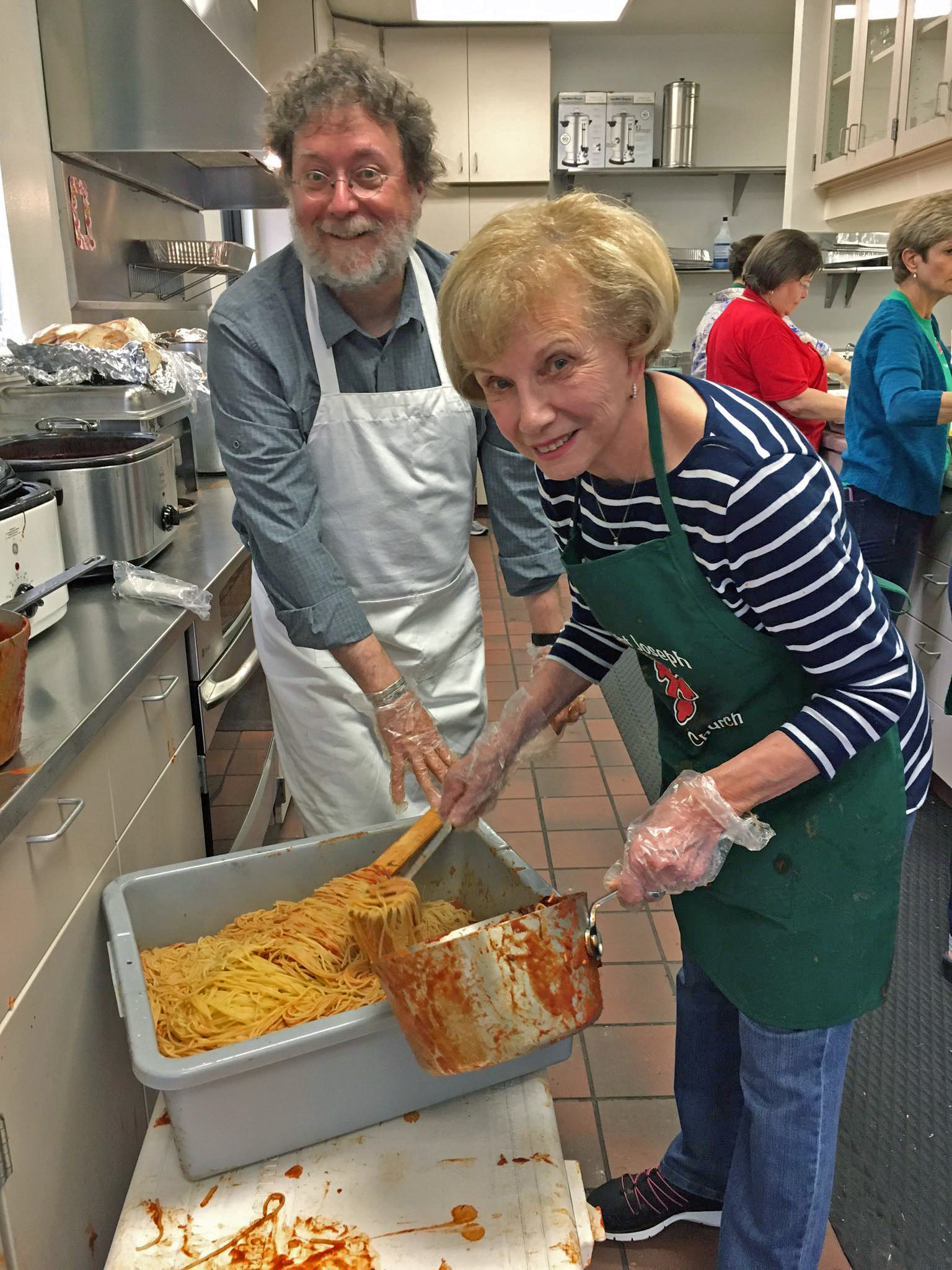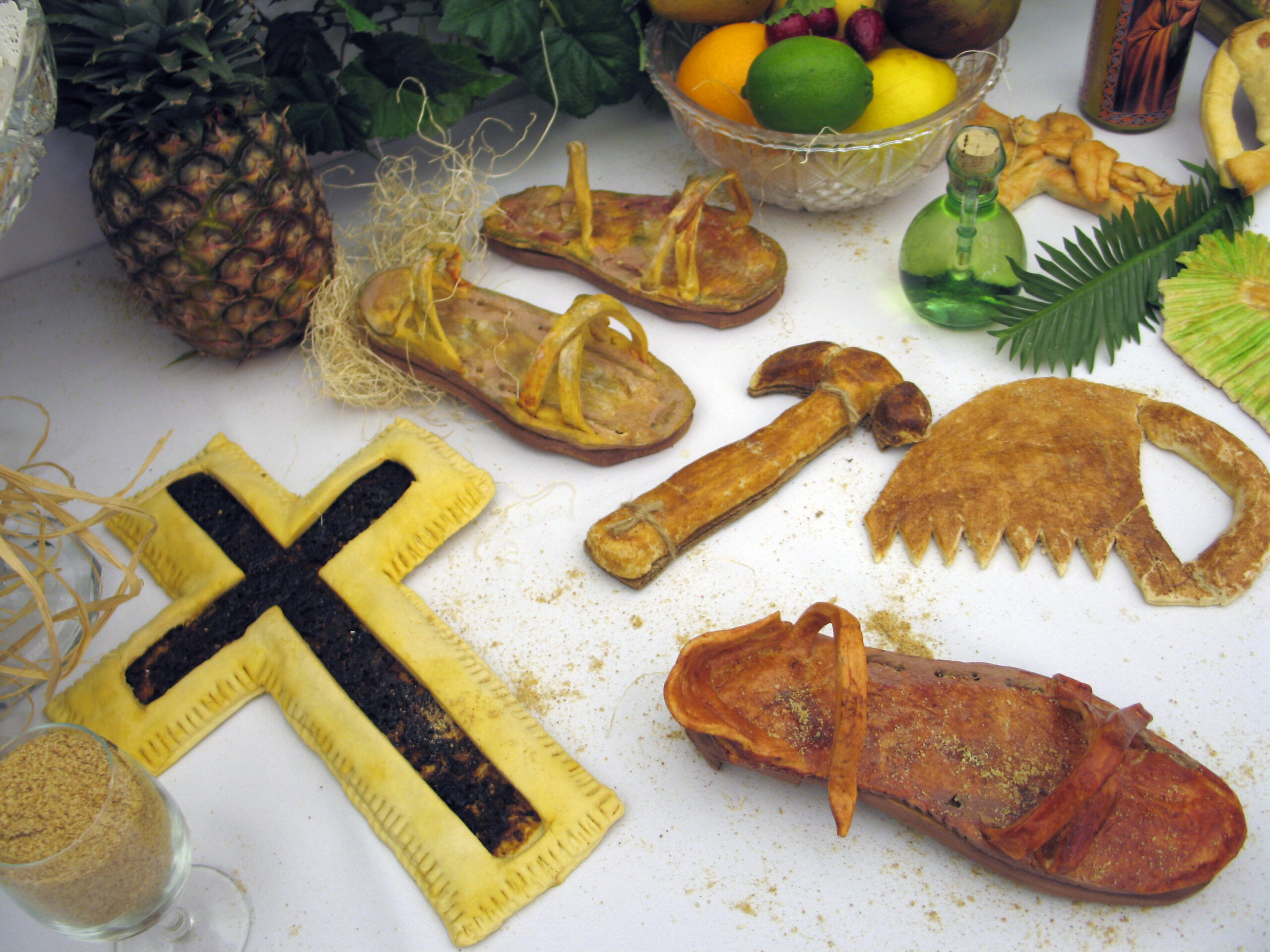St. Joseph's Day altars began as a custom brought to New Orleans by Sicilian immigrants.
 The Italian tradition of a St. Joseph Table is a popular devotion for the Feast of St. Joseph.
The Italian tradition of a St. Joseph Table is a popular devotion for the Feast of St. Joseph.
This celebration featuring a makeshift shrine is a symbolic “thank you” and renewal of the Sicilian people’s devotion to St. Joseph.
Info from the Archdiocese of New Orleans:
Here’s how to set up your own St. Joseph Table at home or at your parish:
 STEP 1: Choose a date and invite guests. If March 19 is not possible, celebrating a day or two before or afterwards is OK. It is ideal to host the celebration after Mass. Invite guests, especially children to dress up and play the parts of the Holy Family, the Apostles and angels. Guests should bring decorations or food items for the table.
STEP 1: Choose a date and invite guests. If March 19 is not possible, celebrating a day or two before or afterwards is OK. It is ideal to host the celebration after Mass. Invite guests, especially children to dress up and play the parts of the Holy Family, the Apostles and angels. Guests should bring decorations or food items for the table.
STEP 2: Set up the table. Place a table in a prominent location of your home or church. On the table, arrange at least two display tiers using durable boxes or small shelves. (The three tiers represent the Holy Trinity, and the ascent from earth to heaven.) Cover the table and tiers with a white tablecloth.
STEP 3: Decorate the table. Place a statue of St. Joseph on the top tier. On the other tiers, display flowers (white lilies, in particular), candles, statues, rosaries and holy cards. The setup should be solemn and festive – use your imagination! Vigil lights of green, brown and yellow (representing St. Joseph’s clothing) can be placed all around, and the table can be surrounded by palms reminiscent of the Holy Land.
STEP 4: Set out a basket to collect prayer intentions and alms for the poor. You might collect canned goods for a food pantry or have a cash donation basket.
STEP 5: Prepare the menu. One traditional main dish in Sicily is “Carpenter’s Pasta” – pasta made with bread crumbs sautéed in butter to resemble sawdust – but you can include fish, soups or other pasta. Cheese isn’t used, symbolic of the food shortage experienced in the origin legend of the tradition. Sesame-coated artisan breads in symbolic shapes are a key centerpiece of the table and the menu. Don’t forget to include dessert: cakes, biscotti and cookies embellished with almonds are common. For menu ideas, go to www.yearofstjoseph.org.
STEP 6: Gather and place specific foods on the table. Special breads, fruits, vegetables, baked goods, pasta, wine and olives are all traditional items found on a St. Joseph’s Table. But as it is Lent, omit any meats and cheeses. Arriving guests should place their items on or around the table.
STEP 7: Bless the St. Joseph Table. Before or at the start of your celebration, invite a priest or deacon to bless your table, or pray together as a family.
STEP 8: Eat. The three children representing the Holy Family eat first, and they sit at a small table reserved just for them. Food is served buffet style.
STEP 9: Pray. After the meal, pray together as a group, seeking St. Joseph’s intercession. Pray the Litany to St. Joseph or use the diocese’s St. Joseph Prayer Book for other ideas. To end the celebration, offer guests a small gift such as a St. Joseph holy card. When possible, deliver the items collected for the poor to conclude the devotion.
The Foods
 And, as it has developed, there are two constants for the “table”: there is no meat (since it’s Lent) and the presence of sesame-coated breads in symbolic shapes.
And, as it has developed, there are two constants for the “table”: there is no meat (since it’s Lent) and the presence of sesame-coated breads in symbolic shapes.
(Again, if the celebration happens after an evening Mass, the food that is served may simply be desserts and coffee.)
Breads, baked into symbolic shapes, are the centerpiece of the food table and the altar. The breads themselves are made from the same dough that forms traditional Italian bread and are often made into interesting and symbolic shapes for St. Joseph’s Day. For examples, see the section below.
Other foods that are often present at more elaborate St. Joseph’s Table “feasts” include:
Minestras, or very thick soups, are made of lentils, favas and other types of beans, together with escarole, broccoli or cauliflower. Other vegetables–celery, fennel stalks, boiled and stuffed artichokes–are also traditional.
St. Joseph’s Day Pasta, also called Sawdust Pasta or Carpenter’s Pasta, made with bread crumbs sautéed in butter to resemble wood sawdust. Cheese isn’t used, symbolic of the food shortage experienced in the origin legend of the tradition.
Sweet Pasta, a pasta dish made with honey.
Olives, figs, and other side dishes.
As no feast is complete without dessert, no Saint Joseph’s altar would be finished without the flourish of sweet items. There is typically a plethora of cakes, biscotti and cookies, many of which are embellished with almonds.
Two particularly traditional desserts found at St. Joseph’s tables are sfingi–fried pieces of bread dough rolled in sugar—and zeppoli–a pastry shaped like a donut, fried or baked, and filled with a sweet pastry crème, then garnished with a dusting of powdered sugar and a maraschino cherry.
Artisan Breads
Some of the most typical “artistic” breads are:
 The Latin Cross: The ultimate symbol of our Lord’s suffering and salvation.
The Latin Cross: The ultimate symbol of our Lord’s suffering and salvation.
The Bambino: The baby Jesus to whom St. Joseph was foster father.
St. Joseph’s Staff: Legend has it that St. Joseph’s staff blossomed into a lily, a symbol both of life and death.
St. Joseph’s Purse: This symbol is a reminder to give alms to the poor during Lent.
A Sheaf of Wheat: Wheat is a reminder that, when a single, tiny grain of wheat falls into the ground and dies, it bears much more food at harvest time—and that the early spring harvest of greens is almost here.
St. Joseph himself: He is always represented in profile and hunched over with a cane, symbolizing that he was (according to tradition) an old man, while Mary was a much younger woman.
St. Joseph’s Beard: This is actually just the Sheaf of Wheat turned upside down, but young children delight when their fathers and grandfathers hold their beard up to their face. It is another reminder of Joseph’s wisdom and old age.
Heart: A symbol of devotion to the Sacred Heart of Jesus and the Immaculate Heart of Mary that flourished throughout Italy in general and Sicily in particular in the 19th century.
The Crown of Thorns: This is in remembrance of Christ’s passion and a reminder that, despite the day’s feasting among Lent’s fasting, Lent is still a season of sorrow—but of hope, too!
The Poor
Beautiful as the Saint Joseph’s Day Table is to behold, it is a work of art that is also practical, meant to not only feed not only those present, but also the absent hungry.
The table’s breads, cookies and pastries are sold to raise funds for the parish or for charity. Donations of other food items, as well as cash donations, are encouraged. Even if celebrated privately, at home, a plan should be in place to make sure that the entire celebration and charitable nature of the event serve those most in need.
Other Interesting St. Joseph’s Table Traditions:
 No cheese is eaten on St. Joseph’s day, a remembrance that during the famine that spawned this devotion, cheese was not available. Pasta is not sprinkled with grated cheese, but in its place a traditional mixture of tasted dry bread crumbs with fresh sardines and fennel sauce is used.
No cheese is eaten on St. Joseph’s day, a remembrance that during the famine that spawned this devotion, cheese was not available. Pasta is not sprinkled with grated cheese, but in its place a traditional mixture of tasted dry bread crumbs with fresh sardines and fennel sauce is used.
Blessed fava beans are often given out at St. Joseph’s Tables. Once considered cattle feed, fava beans were the one food which survived the Sicilian drought, sustained the people, and saved them from starvation.
The use of bread crumbs in food preparation is said to represent saw dust in commemoration of St. Joseph’s work as a carpenter.

